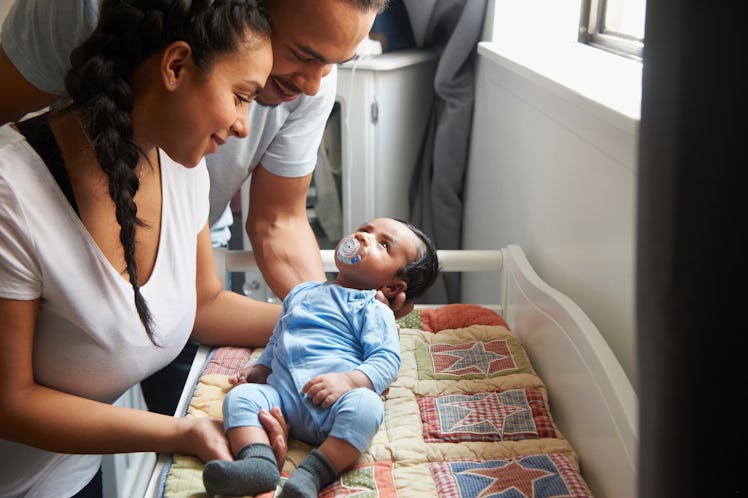When Can You Start Sleep Training? A Pediatric Sleep Expert Explains
Three months, if baby cooperates.

After a few weeks of shushing and rocking, wailing and feeding, many parents are ready to start sleep training. So very ready. But is baby? When can you start sleep training?
There are two basic components that need to be in place for a baby to be developmentally ready for sleep training. The first is for them to be physically capable of self-soothing, which usually happens at around three months. The second is the ability to go all night without needing to be fed, which happens at four- to six-months for most babies.
If you’re waiting until the four- to six-month period, Natalie Barnett, Ph.D., a pediatric sleep expert at Nanit and founder of Seven Oaks Sleep Science, thinks you might have missed the boat. For the first couple of months, a baby’s nervous system is not developed enough for them to self-soothe, so parents can do all the rocking and cuddling and singing they please before putting baby down. But at about 3 months, babies start being able to fall asleep on their own at the beginning of the night.
This is a perfect opportunity to make baby’s transition to sleep training easier. At the 3-month mark, continue to do your regular nighttime routine — feed, change, jammies, lullaby, whatever your cozy bedtime ritual has become — and then place baby in the crib or bassinet before they fall asleep. This allows the baby to get used to falling asleep by themself, a skill that will come in handy a month or so later when you start training them to fall back asleep without parental intervention after they wake up in the middle of the night.
“What you’ve got to remember is that what your baby needs to fall asleep at the beginning of the night is what they’re going to need to get themselves to go back to sleep when they wake up during the night,” says Barnett. “If that is a bottle, if that is being held, if that is being rocked, then your baby is going to need exactly that when they wake up during the night.”
Below are a few more best practices Barnett has to make sleep training easier for parents and baby:
Ditch the Swaddle
Sleep training is the time to do away with the swaddle or magic sleep suit. These techniques work great for young ones who can’t yet self-soothe, but your baby will need hands-free, unrestricted movement to be able to teach themself to fall back asleep. “That may be that they suck on a finger, that they twirl their hair — whatever your baby’s sleep associations are going to be, we want to give them the chance to work that out for themselves by having their hands free,” says Barnett.
Transition to a Crib
A very small sleeping space is fine for a swaddled baby. But as they gets a little bit older and are starting to move around, Barnett recommends allowing baby’s movements to be as unrestricted as possible at night.
Focus on Daytime Feedings
A baby’s ability to go all night without a feeding is partly dependent on getting enough calories in during the day. Barnett advises parents to stay focused on those daytime ounces so that cutting back on nighttime feeds feels natural for baby.
Relinquish the Pacifier
Barnett recognizes that this one is a bit contentious, and she loves the pacifier for younger ones who can’t yet self-soothe, but as baby enters sleep training a pacifier can make their transition more difficult. That’s due to Barnett’s golden rule: If your baby needs a pacifier when they’re falling asleep at the beginning of the night, they’re typically going to need that pacifier when they wake up in the middle of the night to go back to sleep. “At 4 months, it’s really difficult for a baby to have the coordination to pick up that pacifier and put it back in their mouth,” says Barnett. “It’s going to cause more frustration than it’s worth.”
Consistency
It doesn’t matter to Barnett which sleep training method you choose, as long as you’re consistent. She coaches families that it’s normal, whether you’re an adult or a 6-month-old, to feel the frustration that comes with sleep training. “Give yourselves time to work through it,” she says.
This article was originally published on